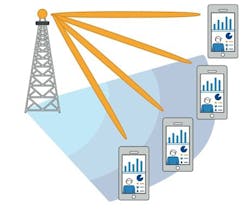5G Hype vs. Reality: Overcome These Challenges to Achieve “Real” 5G Deployment
Several telecommunications carriers, wireless equipment manufacturers, and smartphone makers have burst out of the gates this year with plans to accelerate 5G deployment and adoption. Greater emphasis at major trade shows like the Consumer Electronics Show and Mobile World Congress have further fueled the 5G hype machine. As a result, it can be hard to separate fact from fiction with these declarations saturating the conversation.
Arun Mulpur, industry marketing manager for communications, electronics, and semiconductors at MathWorks, answered several 5G FAQs, offering perspective to sift through the hype, examine engineering challenges presented by 5G, and find out when 5G will become a reality.
Why is 5G so meaningful, and how does the transition from 4G to 5G compare to the transition from 3G to 4G?
The change from 3G to 4G was more of an evolutionary change. It was an incremental, one-step change because the required specifications were very similar. The transition from 4G to 5G, however, will be a fundamental, revolutionary change. One of the biggest differences is that 5G designs will have to factor in elements like massive MIMO (i.e., multiple antennas and multiple RF front ends).
5G will have wide-reaching impact, not only on wireless or cellular-based internet service, but also across a range of applications, such as narrowband Internet of Things (IoT) technologies. For that reason, 5G and the technologies it will enable are worthy of the hype, but there are still hurdles to clear before 5G becomes a reality.
Which hurdles must be cleared before 5G is deployed?
I’ll go back specifically to massive MIMO and multiple RF front ends. Because of these two issues, RF design and baseband design need to be done in lockstep.
In the past, the engineering reality was that either the standards were not fully set, or design teams were geographically or ideologically separated. It was never the case that RF and baseband teams worked together until they started verifying their designs later in the design phase. Today, most 5G design teams working with major base-station companies are fundamentally changing the way they tackle RF and baseband design because of these two issues.
Beamforming directs 5G signals to user equipment to speed up data rates and increase bandwidth. (Courtesy of MathWorks)
5G specification is so dauntingly different and challenging, particularly from an RF perspective, that massive-MIMO applications can no longer be left as an afterthought. Ultimately, you must iterate on that design. Therefore, baseband design teams are now in lockstep when it comes to integrating those RF effects.
How can design engineers use simulation, prototyping, and verification to overcome these challenges?
Part of MathWorks’ methodology has been to go back and look at the experience of a base-station vendor in the 4G generation. What we learned was that design teams need to be able to iterate quickly as changes arise. The most successful design teams can account for changes in one place (e.g., in an executable specification in a model) and reflect that same change in simulation, prototyping, and deployment on the radio testbed or field trial. Companies that are first to market and have the most reliable offerings will be the ones that can streamline this entire sequence and understand how a specific change gets quickly propagated through all of these stages into the field trial.
This will be crucial for companies looking to gain a competitive advantage in the 5G transition. Having both a goal and difference model during this rapid design iteration, and having engineering change management throughout this process, will enable design teams to make changes once and propagate them seamlessly all the way down the documentation. These things are going to make a huge difference in terms of first to market.
What is the industry currently doing to overcome the challenges 5G presents to accelerate deployment?
One of the key challenges is how well algorithms can be translated into viable hardware and software designs, and how soon and how reliably a test case can be deployed in a testbed. Even if you have the best system designers developing 5G-compliant algorithm designs, but don’t have the means to quickly deploy those designs into hardware and software prototypes, you will fail.
To conquer this challenge, leading companies have invested in adopting improved workflows to provide an integrated path from developing and simulating algorithms and models to quickly deploying them in software and hardware implementations. That workflow from modeling and simulation to rapid prototyping, implementation, and verification is enabling engineers to accelerate innovation by transforming any changes in the algorithms to verification testbeds and field trials.
With wireless providers beginning to actively promote 5G, how should we interpret what’s legitimate and what’s just hype? When can we expect real 5G deployment?
This is a difficult question to answer. There’s no doubt that all major vendors are eventually going to have viable 5G networks sooner rather than later. Everybody is excited to monetize these new technologies and exploit the hype. However, there’s a difference of opinion on how fast 5G-capable mobile devices will come to market, and more importantly, how widespread 5G networks will be upon their deployments. Even today, 4G/LTE coverage maps of North America have gaps.
4G LTE has been around for a while, yet large areas of the country still don’t have access. So, when 5G is deployed, it will not be accessible to everyone. Moreover, equipment vendors and network providers are probably going to be ready sooner than the mobile device market. Additionally, we must consider that handheld devices capable of tapping into the 5G network will still need to be designed, ratified, validated, and mass-produced.
To learn more about how you can explore key technologies for the emerging 5G standard, download the ebook, Development of 5G Technology with MATLAB.


